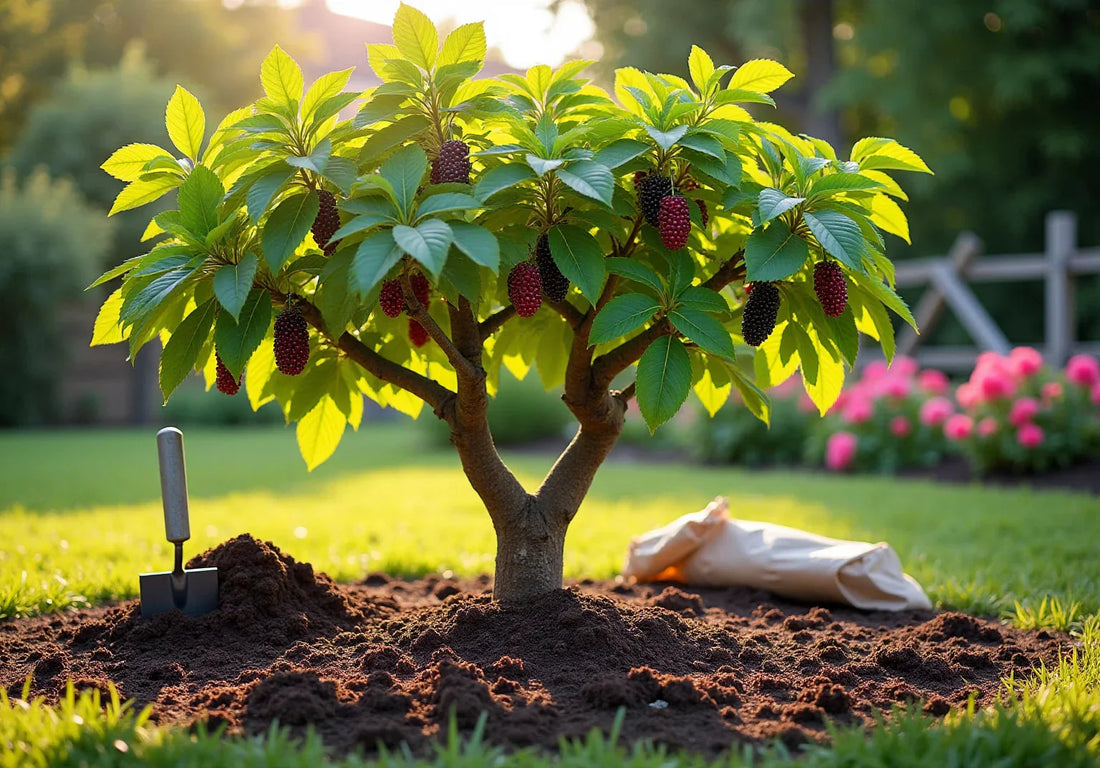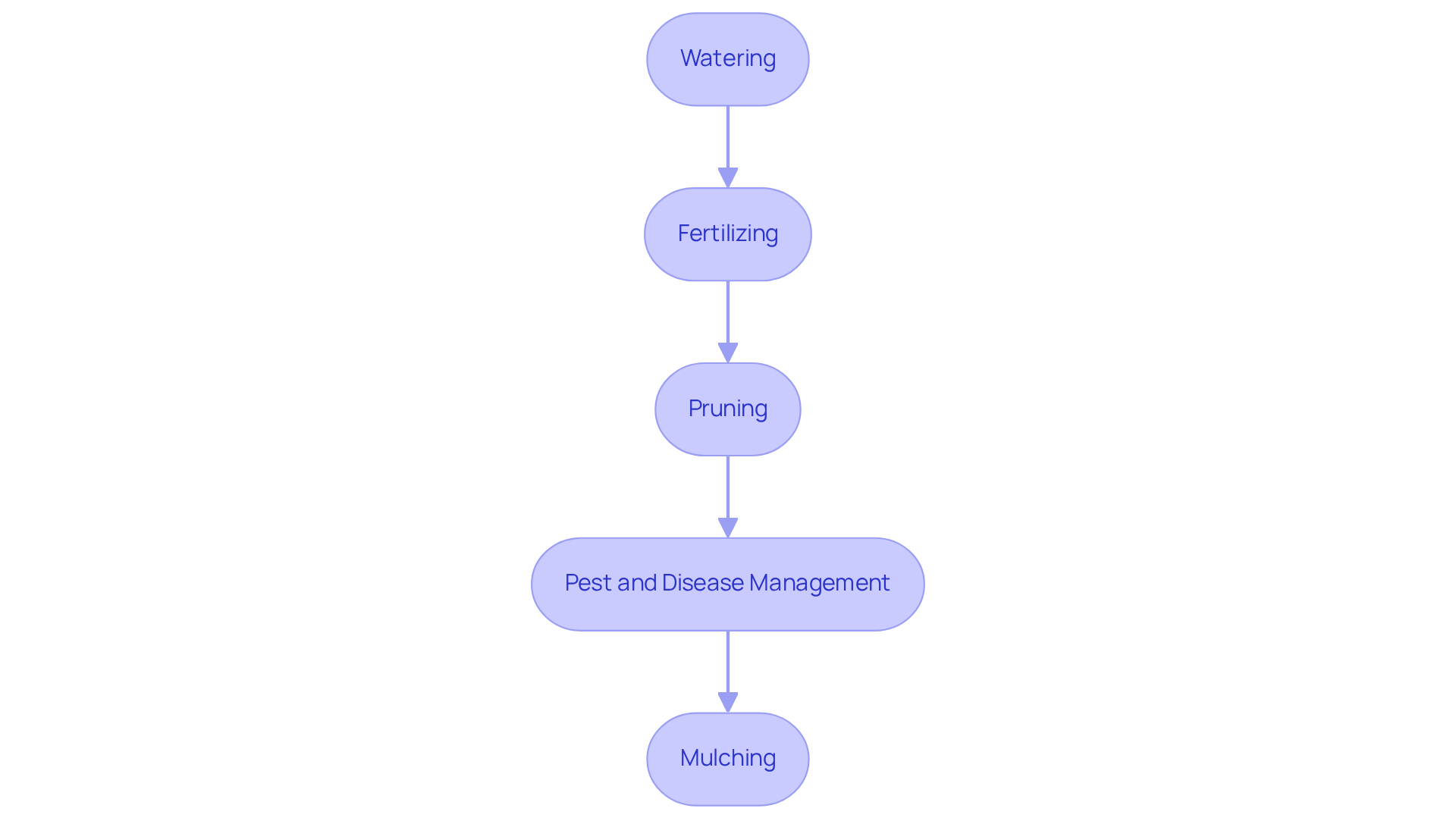
Mastering Mulberry Tree Care: Steps for Healthy Growth
Share
The mulberry tree, recognized for its rapid growth and sweet, edible fruits, offers a distinctive opportunity for gardeners looking to enrich their landscape. With appropriate care and a comprehension of its specific requirements, these trees can flourish and yield generous harvests. However, many aspiring gardeners encounter obstacles, ranging from choosing the perfect planting location to addressing pest and disease management. What are the crucial steps to ensure a healthy, productive mulberry tree that not only enhances the garden's beauty but also supports the ecosystem?
1. Understand Mulberry Tree Basics
The term refers to mulberry tree plants (Morus spp.). The mulberry tree is a deciduous species renowned for its rapid growth and sweet, edible fruits, making it an excellent addition to Everglades Farm's Fast-Growing Trees collection. Thriving in USDA zones 4 to 8, these plants prefer full sun but can adapt to partial shade. They demonstrate remarkable adaptability to various soil types; however, they flourish best in well-drained, nutrient-rich soils with a slightly acidic to neutral pH, ideally between 5.5 and 7.0.
Depending on the variety of the mulberry tree, mulberry berries can reach impressive heights:
- White varieties can grow up to 80 feet
- Red ones can reach 70 feet
- Black ones typically grow around 30 feet
Notably, the black variant is limited to USDA Hardiness Zone 7, whereas the white species can withstand temperatures as low as -25°F, although some clones may experience damage at 25°F. Understanding these growth traits, including the spacing requirement of at least 15 feet apart, is crucial for selecting the ideal planting site and implementing effective care methods for your shrub.
Additionally, it's important to acknowledge that this plant can take 10 years or longer to produce fruit from seed, which is vital for setting realistic expectations for novice gardeners. By choosing Everglades Farm, you can explore a variety of fast-growing tropical plants that promise swift gardening success.

2. Plant Your Mulberry Tree Correctly
-
Choose the Right Location: Selecting a site that receives full sun for at least six hours daily is crucial. Additionally, ensure that the area around the mulberry tree has excellent drainage to prevent waterlogging, as these trees thrive in well-drained soil.
-
Prepare the ground: Testing the soil's pH is essential, aiming for a range of 6.2 to 6.8, which is ideal for the mulberry tree's growth. Amend the soil as necessary by incorporating organic matter, such as compost, to enhance both fertility and drainage.
-
Dig the Hole: Create a hole that is twice as wide and deep as the root ball of the plant. This approach allows the roots to spread easily, establishing a robust foundation for growth.
-
Plant the Sapling: Carefully remove the sapling from its container, gently teasing apart any circling roots. Position the plant in the center of the hole, ensuring that the top of the root ball is level with the surrounding soil.
-
Backfill and Water: Fill the hole with soil, gently tamping it down to eliminate air pockets. Thoroughly water the plant to help settle the soil around the roots, promoting good contact between the roots and the soil.
-
Mulch: Applying a layer of mulch around the base of the plant is beneficial for retaining moisture and suppressing weeds, which can compete for nutrients and water. This practice not only supports healthy growth but also enhances the overall well-being of the plant.

3. Care for Your Mulberry Tree
-
Watering is essential, as newly planted mulberry trees necessitate consistent irrigation, particularly during dry spells. Aim to water deeply once a week, ensuring the soil remains moist but not waterlogged. For optimal development and fruit yield, a mulberry tree requires a minimum of 1 inch of water each week. Consider utilizing a soaker hose to water multiple trees simultaneously, ensuring deep soaking of the root system.
-
Fertilizing: To promote healthy development, apply a balanced fertilizer in early spring. A slow-release fertilizer containing equal parts nitrogen, phosphorus, and potassium is ideal. Fertilize once per year in late winter, using approximately 1 pound of fertilizer for each inch of trunk diameter. This method enhances nutrient availability and supports robust growth rates.
-
Pruning your mulberry tree should be done in late winter or early spring while it is dormant. Remove any dead or diseased branches and shape the plant to encourage an open canopy, allowing sunlight to penetrate effectively. Proper pruning not only maintains the health of the mulberry tree but also enhances the quality of its fruit.
-
Pest and Disease Management: Regularly inspect your plant for pests such as aphids, whiteflies, or scale insects. If necessary, treat infestations with organic insecticidal soap or horticultural oil. Ensuring good air circulation around the plant can help prevent fungal diseases, which thrive in damp conditions.
-
Mulching: Maintain a 3-inch layer of mulch around the base of the plant to conserve moisture and suppress weeds. Mulching not only retains moisture in the ground but also improves nutrient content, especially when using organic materials. This practice enhances overall plant health and growth.

4. Troubleshoot Common Mulberry Tree Problems
-
Yellowing Leaves: Yellowing leaves often signal overwatering or nutrient deficiencies. To address this, check the moisture levels in the ground; if it is consistently wet, reduce watering. Additionally, consider applying a balanced fertilizer to replenish essential nutrients, as studies indicate that nutrient deficiencies can significantly impact leaf health. These plants play a crucial role in water and earth preservation, making adequate maintenance essential for their wellbeing and the ecosystem.
-
Wilting: Wilting may indicate underwatering or root rot. Ensure your mulberry tree receives adequate water, particularly during dry spells. If the ground holds excessive moisture, enhance drainage to avert root decay, which can be harmful to the plant's health. A strong root system is vital for preventing soil erosion and enhancing overall soil health, as it helps maintain soil integrity and supports the plant's growth.
-
Pest Infestations: Look for signs of pest infestations, such as holes in the leaves or sticky residue. If detected, treat the plant with organic insecticides or introduce beneficial insects like ladybugs, which can help manage pest populations naturally. Effective pest management is crucial for preserving the vitality of your mulberry tree.
-
Poor Fruit Production: If your plant is not yielding fruit, it may not be receiving adequate sunlight or nutrients. Ensure it is planted in a location that receives full sun for most of the day. Pruning can also enhance fruit production by allowing more light to penetrate the canopy, encouraging healthier growth and fruiting.
-
Diseases: Fungal infections, such as powdery mildew, can be controlled by enhancing air circulation around the plant. Regularly clean up fallen leaves to minimize disease risk, and apply fungicides if necessary. Maintaining the health of your mulberry tree not only enhances its beauty but also contributes to environmental benefits, such as improved air quality and biodiversity. As Sir David Attenborough said, "Ancient trees are precious. There is little else on Earth that plays host to such a rich community of life within a single living organism.
Conclusion
Mastering the care of mulberry trees is essential for ensuring their healthy growth and bountiful fruit production. By understanding the unique characteristics and requirements of these trees, gardeners can create an optimal environment that fosters robust development while minimizing potential issues.
Throughout this guide, key points have been highlighted, including:
- The importance of proper planting techniques
- Consistent watering
- Regular maintenance practices such as fertilizing and pruning
Recognizing the signs of common problems, from yellowing leaves to pest infestations, equips gardeners with the knowledge to address challenges proactively and maintain the vitality of their mulberry trees.
Ultimately, successful mulberry tree care not only enhances the beauty and productivity of a garden but also contributes to ecological health and biodiversity. Embracing these practices can lead to a thriving landscape where these remarkable trees flourish, offering sweet rewards for years to come. For those eager to cultivate their own mulberry trees, implementing these strategies will pave the way for a fruitful gardening journey.
Cultivate Your Own Mulberry Paradise Today!
Start now with Everglades Farm and watch your garden flourish with vibrant, fruitful trees.
Frequently Asked Questions
What is a mulberry tree?
A mulberry tree refers to plants of the species Morus spp., known for their rapid growth and sweet, edible fruits.
What USDA zones are suitable for growing mulberry trees?
Mulberry trees thrive in USDA zones 4 to 8.
What are the sunlight and soil preferences for mulberry trees?
Mulberry trees prefer full sun but can adapt to partial shade. They flourish best in well-drained, nutrient-rich soils with a slightly acidic to neutral pH, ideally between 5.5 and 7.0.
How tall can different varieties of mulberry trees grow?
White varieties can grow up to 80 feet, red varieties can reach 70 feet, and black varieties typically grow around 30 feet.
Are there any temperature limitations for mulberry tree varieties?
The black mulberry variant is limited to USDA Hardiness Zone 7, while the white species can withstand temperatures as low as -25°F, although some clones may experience damage at 25°F.
What is the recommended spacing for planting mulberry trees?
Mulberry trees should be spaced at least 15 feet apart for optimal growth.
How long does it take for mulberry trees to produce fruit from seed?
Mulberry trees can take 10 years or longer to produce fruit from seed, so it's important for novice gardeners to set realistic expectations.

